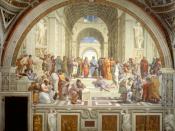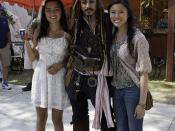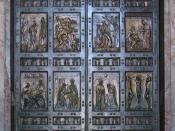As the fourteenth century ushered out the Middle Ages in Italy, a new period of cultural flowering began, known as the Renaissance. This period in history was famous for its revival of classical themes and the merging of these themes with the Catholic Church. These themes of humanism, naturalism, individualism, classicism, and learning and reason appeared in every aspect of the Italian Renaissance, most particularly in its art.
Humanism can be defined as the idea that human beings are the primary measure of all things (Fleming, 29). Renaissance art showed a renewed interest in man who was depicted in Renaissance art as the center of the world. Pico della Mirandola said that, "there is nothing to be seen more wonderful than man." (Fleming, 284) This could almost be taken as a motto for Renaissance art.
Michelangelo's David clearly supports Mirandola's statement.
Since Renaissance art focused on representing tangible, human figures, rather than depicting scenes from the Bible in order to praise God, the artists had to think in more natural, scientific terms.
Artists became familiar with mathematics and the concept of space, as well as anatomy. Lorenzo Ghiberti studied the anatomical proportions of the body, Filippo Brunelleschi was interested in mathematics in architecture, Leone Battista Alberti, who was skilled in painting, sculpture and architecture, stressed the study of mathematics as the underlying principle of the arts (Fleming, 285). Leonardo also looked at the geometric proportions of the human body (Calder, 197). In painting, but especially in sculpture, artists were inspired to express the structural forms of the body beneath its external appearance. Their anatomical studies opened the way to the modeling and the movements of the human body. In painting, naturalism meant a more realistic representation of everyday objects. In Fra Angelico's Annunciation, he shows an exact reproduction of...


